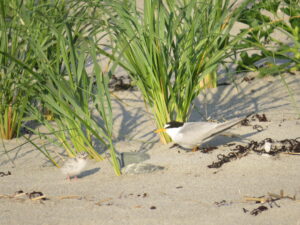(Story and photos by Pam Hunt)
The appropriately-named Least Tern (Sternula antillarum) is the smallest of the four tern species that breed in New Hampshire, but unlike its larger relatives it is a bird of beaches rather than rocky islands. This puts it in more direct conflict with human interests than species which nest in more remote locations, and perhaps as a result its history as a breeder in the state has been both shorter and more tenuous.
Like other coastal birds, Least Terns fell victim to the demand for hat decorations in the late 1800s, and if there was a population nesting in New Hampshire a century ago there is no concrete record of it. The first recorded nest was found in Seabrook in 1926, and probably reflects growing regional populations to the south in Massachusetts. They continued breeding in Hampton and Seabrook until 1959, but subsequently declined even as visitors through the 2000s.

But by the mid-1990s, conservation efforts for Federally Threatened Piping Plovers were starting to pay off, and populations of that other beach-nester were rebounding in the Gulf of Maine. In 1997, plovers nested on New Hampshire’s beaches for the first time in over 20 years, and efforts were immediately implemented to ensure their success. Conservation measures included “symbolic fencing” to reduce human encroachment into nesting areas, predator exclosures, and extensive educational outreach to towns and beach-goers. All these efforts worked, and by the 2020s there were over a dozen pairs of plovers nesting in the state.
What does this have to do with terns? Since they share the same habitat, Least Terns also benefitted from efforts to nesting areas, and in 2015 two pairs attempted to nest and managed to fledge a single chick (Figure 1). Since then, their numbers have grown slowly, with some fits and starts, and an estimated 20 pairs were present in 2022.

One reason Least Terns have increased faster than Piping Plovers is that they’re loosely colonial, which allows more pairs to nest in a relatively small area of beach. Nests can be a close as 16” in dense colonies, but a distance of 30-45 feet is more typical. The nest, like that of a Piping Plover, is little more than a depression in the sand, and in this the tern will lay two or three eggs. When these hatch in three weeks the young are able to leave the nest within a couple of days, and often mingle with those from other nests, which can make estimating breeding success difficult. Once they can fly at about three weeks of age it becomes essentially impossible to keep track of them unless they are marked in some way. The parents are not hindered however, and will continue to feed their grown chicks for several weeks. By the end of August they have mostly departed for wintering grounds in offshore waters of the Caribbean and South America, where their ecology is poorly known.
But the following May they’ll be back, ready to find a suitable nesting site in the lee of the Hampton and Seabrook dunes and start the whole cycle all over again. How much more our population can grow is currently unknown, and will depend largely on the success of ongoing conservation efforts. You can do your part by respecting fencing and signage at the beach, keeping dogs on leashes, and spreading the word about these birds that have been using beaches for far longer than we have.
State of the Birds at a Glance:
- Habitat: Beaches and dunes
- Migration: Long-distance
- Population trend: Unknown, but local increases
- Threats: Human disturbance, predation, sea-level rise
- Conservation actions: Protective fencing, beach-goer education
